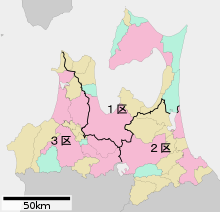Aomori 2nd district
Aomori 2nd district (青森県第2区, Aomori-ken dai-niku or simply 青森2区, Aomori-niku) is a single-member constituency of the House of Representatives in the national Diet of Japan. It is located in Northeastern Aomori and covers the prefecture's Towada, Misawa, and Mutsu cities, Shimokita District, a portion of Kamikita District, and the town of Gonohe within Sannohe District.
| Aomori 2nd District | |
|---|---|
| Parliamentary constituency for the Japanese House of Representatives | |
 Numbered map of Aomori Prefecture single-member districts | |
| Prefecture | Aomori |
| Proportional District | Tōhoku |
| Electorate | 250,364 (2015)[1] |
| Current constituency | |
| Created | 1994 |
| Seats | One |
| Party | LDP |
| Representative | Akinori Eto |
| Created from | Aomori's 1st "medium-sized" district |
| Municipalities | Aomori's Towada, Misawa, and Mutsu cities, Kamikita and Shimokita districts, and the town of Gonohe within Sannohe District |
As of 2015, this district was home to 250,364 constituents, roughly half the number of Japan's largest district, Tokyo 1st district.[2] The district is the northernmost Japanese House of Representatives district on Honshu.
Aomori is a so-called "Liberal Democratic kingdom," meaning that it frequently returns members of Japan's Liberal Democratic Party. The district's current representative, Akinori Eto, has represented the district continuously since 2003, one of few Liberal Democratic representatives not voted out of office during the Democratic Party of Japan's rapid rise to power during the 2009 general election. Eto served as Minister of Defense in 2014, during Prime Minister Shinzō Abe's 2nd cabinet rotation.
List of representatives
| Representative | Party | Dates | Notes | |
|---|---|---|---|---|
| Akinori Eto | LDP | 1996-2000 | Lost re-election | |
| Shingo Mimura | AI | 2000–2003 | ||
| Akinori Eto | LDP | 2003– | Incumbent | |
Election results
| Party | Candidate | Votes | % | ± | |
|---|---|---|---|---|---|
| Liberal Democratic | Akinori Eto (endorsed by Kōmeitō) | 81,054 | 67.48 | ||
| Innovation | Noriko Nakanowatari | 28,282 | 23.55 | ||
| Communist | Ryōko Ogasawara | 10,775 | 8.97 | ||
| Party | Candidate | Votes | % | ± | |
|---|---|---|---|---|---|
| Liberal Democratic | Akinori Eto (endorsed by Kōmeitō) | 81,937 | 65.22 | ||
| Democratic | Tomonobu Nakamura | 18,836 | 14.99 | ||
| Tomorrow | Noriko Nakanowatari (endorsed by NPD) | 18,180 | 14.47 | ||
| Communist | Ryōko Ogasawara | 6,683 | 5.32 | ||
| Party | Candidate | Votes | % | ± | |
|---|---|---|---|---|---|
| Liberal Democratic | Akinori Eto (endorsed by Kōmeitō) | 86,654 | 54.0 | ||
| Democratic | Noriko Nakanowatari (endorsed by PNP) (won in PR district) | 64,334 | 40.1 | ||
| Independent | Hisako Kumagai | 7,164 | 4.5 | ||
| Happiness Realization | Kiyoshi Morimitsu | 2,288 | 1.4 | ||
| Party | Candidate | Votes | % | ± | |
|---|---|---|---|---|---|
| Liberal Democratic | Akinori Eto (endorsed by Kōmeitō) | 89,887 | 58.26 | ||
| Democratic | Tomonobu Nakamura | 46,124 | 29.90 | ||
| Social Democratic | Chiyoji Kinoshita | 13,327 | 8.64 | ||
| Communist | Toshimitsu Ichikawa | 4,941 | 3.20 | ||
| Party | Candidate | Votes | % | ± | |
|---|---|---|---|---|---|
| Liberal Democratic | Akinori Eto | 96,784 | 75.07 | ||
| Social Democratic | Kōichi Saitō | 21,537 | 16.70 | ||
| Communist | Shōko Kudō | 10,605 | 8.22 | ||
| Party | Candidate | Votes | % | ± | |
|---|---|---|---|---|---|
| Independents | Shingo Mimura (endorsed by LP), DPJ) | 80,338 | 46.9 | ||
| Liberal Democratic | Akinori Eto (endorsed by NCP) | 74,118 | 43.3 | ||
| Social Democratic | Chiyoji Kinoshita | 13,112 | 7.7 | ||
| Communist | Naiki Kudō | 3,645 | 2.1 | ||
| Party | Candidate | Votes | % | ± | |
|---|---|---|---|---|---|
| Liberal Democratic | Akinori Eto | 63,672 | 41.9 | ||
| New Frontier | Shingo Mamura | 62,907 | 41.4 | ||
| Democratic | Tsutomu Herai | 11,581 | 7.6 | ||
| Social Democratic | Reiko Tatebe | 8,705 | 5.7 | ||
| Communist | Kazutaka Sōma | 5,235 | 3.4 | ||
References
- Ministry of Internal Affairs and Communications (MIC): (in Japanese)
- Ministry of Internal Affairs and Communications (MIC): (in Japanese)
- Data Sets (in Japanese). Asahi Shimbun. Retrieved 5 November 2016.
- Data Sets (in Japanese). Asahi Shimbun. Retrieved 5 November 2016.
- Data Sets (in Japanese). Yomiuri Shimbun. Retrieved 5 November 2016.
- Data Sets (in Japanese). Yomiuri Shimbun. Retrieved 5 November 2016.
- Data Sets (in Japanese). Election.co.jp. Archived from the original on 24 March 2004. Retrieved 5 November 2016.CS1 maint: BOT: original-url status unknown (link)
- Election 2000 (in Japanese). Election.co.jp. Archived from the original on 28 October 2003.CS1 maint: BOT: original-url status unknown (link)
- 青森県 (in Japanese). Kunitaka Tanaka. Archived from the original on 6 November 2016. Retrieved 5 November 2016.